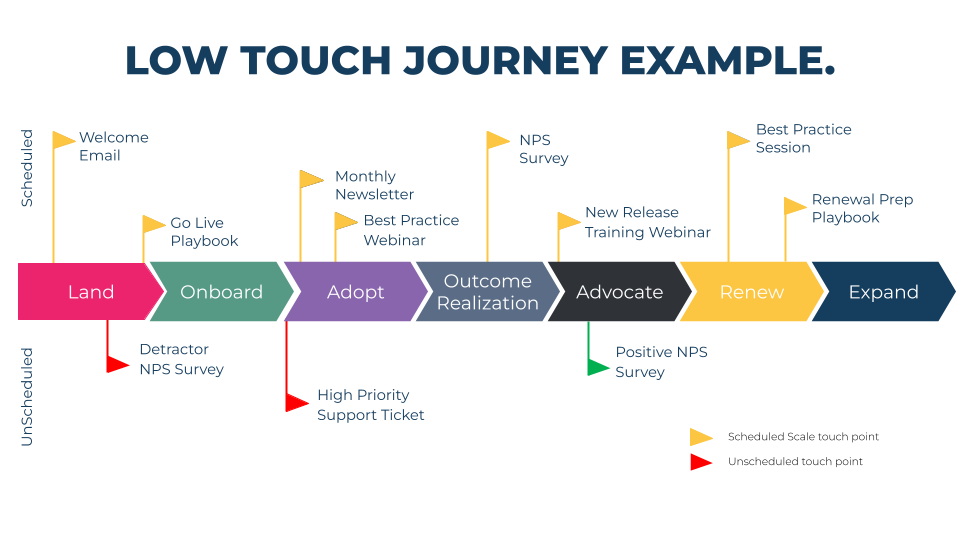In the ever-evolving landscape of customer success, I am excited to share how I see businesses are harnessing the power of digitization to elevate customer engagement and achieve sustainable growth. The rise of 1:Many programs has been a game-changer, revolutionizing the way businesses scale their customer success efforts. These programs play a pivotal role in maximizing efficiency, fostering consistent communication, and identifying growth opportunities within the customer base.
In this post, I want to share my take on how 1:many programs are set to revolutionize businesses across various aspects, ultimately leading to amplified customer satisfaction and growth.
Scalability:
1:Many programs empower customer success teams to reach and engage with a larger number of customers simultaneously. This scalability is crucial as businesses onboard and support a growing customer base without compromising personalized attention.
- Imagine the empowerment of Customer Success Managers (CSMs) when their tools handle routine tasks, allowing them to focus on high-potential customers and handle larger customer volumes.
- With reduced administrative burdens, CSMs can devote more time to strategic customer engagement and nurturing relationships that drive customer success and growth.
Consistent Messaging:
1:Many programs ensure consistent messaging and delivery of information across multiple customers.
- This helps align customer expectations, provide standardized training and support materials, and maintain a cohesive customer experience.
- Creating an impactful digital communication stage for customers is essential, delivering the right messages to the right audience at the right time.
- Let data take the lead in decision-making for customer messaging by leveraging utilization patterns, defined thresholds, and pattern alerts. By analyzing these valuable insights, we can ensure that our communication is targeted, relevant and timely.
Time and Resource Efficiency:
By automating certain aspects of customer success, 1:Many programs save time and resources.
- CSMs can focus on high-touch interactions while still providing valuable resources to a broader customer audience.
- Leveraging initiatives like webinars and training sessions can significantly increase CSM efficiency, allowing them to reach multiple customers simultaneously and ensure effective knowledge transfer.
Proactive Communication:
1:Many programs facilitate proactive communication with customers, enabling consistent updates, best practice sharing, and relevant insights.
- Segmenting customers based on similarities brings efficiency, streamlining workflows and enhancing customer experiences, making their lives easier.
- Recognizing the similarities among customers within the same segment, our Pooled Customer Success Managers (CSMs) can effectively identify common patterns and requests. This valuable insight allows them to develop tailored automations that can be applied across the entire segment, leading to streamlined processes, increased efficiency
Scalable Education and Training:
Through 1:Many programs, businesses can deliver educational resources, webinars, and self-paced training modules to multiple customers simultaneously.
- This approach promotes consistent learning, empowers customers to leverage product capabilities effectively, and encourages adoption and engagement.
Customer Community Building:
1:Many programs often incorporate customer community platforms where customers can interact, share experiences, and learn from each other.
- These communities foster collaboration, knowledge exchange, and peer-to-peer support, enhancing the overall customer experience.
- When the community acts as the frontline Customer Success Manager (CSM), it significantly reduces the workload on our CS and support teams. Customers are motivated to engage with the community, where they find solutions to their problems through peer interactions and shared experiences
Upsell and Cross-Sell Opportunities:
Leveraging 1:Many programs allow businesses to identify upsell and cross-sell opportunities across a wider customer base.
- By delivering targeted messaging and value propositions, businesses can effectively expand their product or service adoption within their customer ecosystem.
As I conclude my exploration of 1:Many programs in customer success digitization, it's evident that they play a pivotal role in driving business growth and enhancing customer experiences. By embracing these programs, businesses can unlock scalability, streamline resource allocation, and ensure consistent messaging across their customer base.
How are you unleashing the full potential of your customer relationships?
Do you agree with the remarkable impact of digitalization and how 1:Many programs are positioned to drive the maturity curve of Customer Success within organizations?
I’d love to hear and learn from you all.
